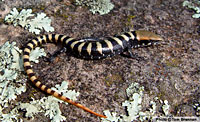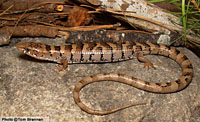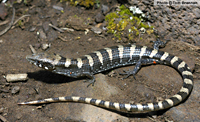Online Field Guide to The Reptiles and Amphibians of Arizona


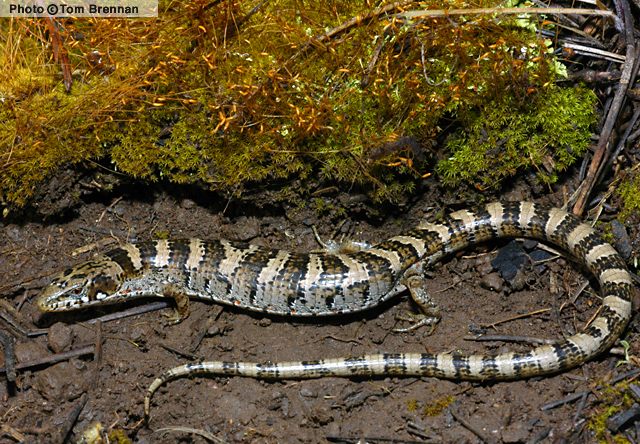
Greenlee County, AZ
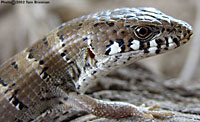 Santa Cruz Co., AZ |
||
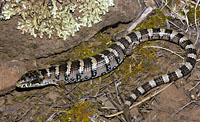 Apache Co., AZ |
| MADREAN ALLIGATOR LIZARD Elgaria kingii |
|
| DESCRIPTION: A large (up to 140 mm or 5.5″ from snout to vent), smooth and shiny lizard with a long body, small limbs, and a long, thick tail. Base coloration is usually tan or gray. Dark brown to red-brown crossbars with dark posterior edges mark the back. There are usually crisp black and white markings on the lips. The original tail is more than twice the length of the body. The back and belly are armored with large, stiff, rectangular, scales that are reinforced with bony plates. A soft fold of skin covered with small rounded scales runs along each lower side of the body from the corner of the mouth to the hind limbs. These folds of skin allow the body to expand for breathing, ingesting prey, and egg development. Males have a broad head and crisp, distinct dorsal pattern. Adult females have a relatively pale dorsal pattern, usually lacking dark posterior borders on the crossbands. Juveniles are marked with distinct dark and light bands on the body and tail, dark limbs, and white spots on the lips. DISTRIBUTION: This lizard’s range covers central Arizona’s Mogollon Rim country and extends south into the southeastern Arizona’s valleys and “sky island” ranges. It is found at elevations ranging from about 3,000′ to over 8,500′. HABITAT: The Madrean Alligator Lizard inhabits a variety of biotic communities in Arizona including broadleaf riparian corridors, Semidesert Grassland, Interior Chaparral, woodlands, and Petran Montane Conifer Forest. It is found in an equally wide variety of terrain types including low valleys, foothills, rocky drainages, canyons, and steep slopes. It frequents moist areas, often in association with loose ground cover such as fallen leaves, pine needles, and other dead plant material.BEHAVIOR: Primarily diurnal and crepuscular. It hibernates during the cold months of winter and late fall. This ground-dweller is often heard rustling through leaf litter before it is seen. When spotted it can be difficult to capture as it quickly slides and zigzags through the ground cover. It is capable of casting off (and regenerating) the tail. Predators and human pursuers often end up with nothing but a wiggling lizard tail. This lizard writhes, expels feces, and often bites when captured. An anti predator behavior was documented by Bowker (1987). A Madrean Alligator Lizard was seized by a Striped Whipsnake. In response, the lizard bit and held the base of its own tail thereby forming a loop. In this looped posture the lizard would presumably be difficult to swallow. If the snake were to “walk” its mouth around the loop in an effort to swallow the lizard head first, the snake would likely end up with a shed lizard-tail in its mouth, providing an opportunity for the lizard to escape. REMARKS: This species has lived to over 15 years of age in captivity.
|
|
Visit Partners in Amphibian and Reptile Conservation:


HOME
Copyright © 2023, Arizona Game and Fish Department. All rights reserved.
If you make use of the textual contents of this site in reports, publications, etc. please cite and credit the author(s) and photographer(s). All photos on this website are copyrighted. However, those found in the species account section may be used for any noncommercial scientific, educational, or conservation purposes provided that photographs are not altered and continue to bear the copyright symbol and name of the photographer. Please contact the photographer regarding commercial use of copyrighted photographs.










